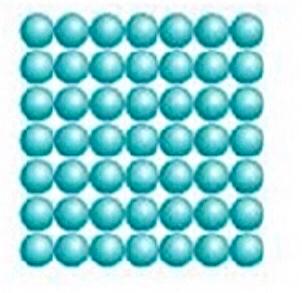ВУЗ: Не указан
Категория: Не указан
Дисциплина: Не указана
Добавлен: 25.10.2023
Просмотров: 47
Скачиваний: 1
ВНИМАНИЕ! Если данный файл нарушает Ваши авторские права, то обязательно сообщите нам.

Сурет 2. Әскери тәртіп және қатты заттар аналогиясы.
Ғылыми кітапта қолданылатын аналогиялар 2-кестеде көрсетілген [6].
| Тұжырымдар | Аналогиялар |
| Томсынның атомдық моделі | Өрік пудингі |
| Резерфордтың атомдық моделі | Футбол алаңы |
| Бордың атомдық моделі | Күн жүйесі |
| Химиялық қосылыс | Пазл бөліктері |
| Иондық байланыс | Магниттік полюстер |
Ғалымдардың зерттеу нәтижелеріне сүйенсек, Оргилл мен Боднердің зерттеу нәтижелеріне сәйкес оқушылардың көпшілігі мұғалімдер сыныпта аналогияны қолданғанды ұнатады дейді [5]. Сарантопулос пен Цапарлис мектеп химиясын оқытуда әлеуметтік байланысты аналогияны қолдануды және оның оқушылардың үлгерімі мен көзқарасымен байланысын қамтитын ұзақ зерттеуді қорытындылады, олар аналогия оқушылардың танымдық деңгейін жақсартып қана қоймай, эмоционалды көңіл-күйін жақсартады деп мәлімдеді. Олар аналогияларды қолдану оң нәтиже бергенін айтты [7].
Аналогия химияны зерттеуде маңызды болып табылады. Көптеген оқушылар сабақтарында күрделі ұғымдарды түсіндіру үшін аналогияларды қолданғанды ұнатады. Бұл барлық химиялық материалдарға қолданылмаса да, олар аналогиялар қызықты деп санайды және пән туралы ақпаратты түсінуге көмектеседі. Оқушылардың пікірінше, оқу процесінде қолданылуы керек жақсы аналогия -бұл табиғи ортадағы объектілерден немесе оқиғалардан туындайтын аналогия, сондықтан оны есте сақтау оңай. Аналогия оқушылардың танымдық деңгейін жақсартып қана қоймай, эмоционалды көңіл-күйін де жақсартады.
Пайдаланылған әдебиеттер тізімі:
-
Demircioglu, G., & Demircioglu, H. (2013) An investigation of chemistry teachers’ understanding of chemical equilibrium. Intenational Journal on New Trends in Education and Their Implications, 4(2):192-199. -
Johnstone, A. H. (1993). The development of chemistry teaching. Symposium on Revolution and Evolution in Chemical Education, 70(9):701-705. -
Glynn, S. M. (2008). Making science consepts meaningful to students: teaching with analogies. 113-125. -
Paiva, J. C., & Gil, V. M. S. (2008). Disciplina de didactica da quimica [Analogies in chemical equilibrium]. Faculdade De Chencias Univesidade Do Porto. 1-19. -
Naseriazar, A., Ozmen, H., & Badrian, A. (2011). Effectiveness of analogies on students’ understanding of chemical equilibrium, Western Anatolia Journal of Educational Science, 525-534. -
Supasorn, S., & Promarak, V. (2015). Implementation of 5E inquiry incorporated with analogy learning approach to enhance conceptual understanding of chemical reaction rate for grade 11 student. Chemistry Education Research and Practice, 16(1):121-132. -
Orgill, M., & Bodner, G. (2004). What research tells us about using analogies to teach chemistry. Chemistry Education: Research and Practice, 5(1):15-32. -
Muniz, M. N., & Hoyo, M. T. (2014). On the use of analogy to connect core physical and chemical concepts to those at the nanoscale. Chemistry Education Research and Practice. 15(4):807-823. -
Orvis, J., Sturges, D., Rhodes, S., White, K. J., Maurer, T. W., & Landge, S. M. (2016). A mailman analogy: retaining student learning gains in alkane nomenclature. Journal of Chemical Education. 93(5):879–885. -
Eskandar, F. A., Bayrami, M., Vahedic, S., & Ansar, V. A. A. (2013). The effect of instructional analogies in interaction with logical thinking ability on achievement and attitude toward chemistry. Chemistry Education Research and Practice, 14(4):566-575. -
Harrison, A. G., & Coll, R. K. (2008). Using analogies in middle and secondary science classrooms. California: Corwin Press. -
Orgil, M., Bussey, T. J., & Bodner, G. M. (2015). Biochemistry instructors’ perceptions of analogies and their classroom use. Chemistry Education and Practice. 16(4):731-746. -
Sarantopoulos, P., & Tsaparlis, G. Analogies in chemistry teaching as a meand of attainment of cognitive and affective objectives: a longitudinal study in a naturalistic setting, using analogies with strong social content. Chemistry Education: Research and Practice. 5(1):33-50. -
Raviolo, A., & Garritz, A. (2009). Ananlogies in teaching of chemical equilibrium: a synthesis/analysis of the literature. Chemistry Education Research and Practice. 10(1). 5-13. -
Calik, M., Ayas, A., & Coll, R. K. (2009). Investigating the effectiveness of an analogy activity in improving students’ conceptual change for solution chemistry concepts. International Journal of Science and Mathematics Education. 7(4):651-676. -
Supasorn, S., & Promarak, V. (2015). Implementation of 5E inquiry incorporated with analogy learning approach to enhance conceptual understanding of chemical reaction rate for grade 11 student. Chemistry Education Research and Practice, 16(1):121-132. -
Harrison, A. G., & Treagust, D. F. (1993). Teaching with analogies: a case study in grade-10 optics, Journal of Research in Science Teaching, 30(10):1291-1307. -
Thiele, R. B., & Treagust, D. F. (1992). Analogies in senior high school chemistry textbooks: a critical analysis. Science and Mathematics Education Centre Curtin University of Technlogy. 1-19. -
Hubber, P., Tytler, R., & Haslam, F. (2010). Teaching and learning about force with a representational focus: Pedagogy and teacher change. Research in Science Education, 40, 5–28. -
Issing, L.J. (1990). Learning from pictorial analogies. European Journal of Psychology of Education, 5, 489- 499. -
Petrie, H.G. & Oshlag, R.S. (1993). Metaphor and learning. In A. Ortony (Ed.), Metaphor and thought. New York: Cambridge University Press. -
Thagard, P., Holyoak, K., Nelson, G., & Gochfeld, D. (1990). Analog retrieval by constraint satisfaction. Artificial Intelligence, 46, 259-310 -
Thagard, P. (1992). Analogy, explanation, and education. Journal of Research in Science Teaching. 29, 537–544. -
Treagust, D. F. (1993). The evolution of an approach for using analogies in teaching and learning science. Research in Science Education. 23, 293–301. -
Treagust, D. F., Harrison, A. G., Venville, G. J.,(1998) Teaching Science Effectively With Analogies: An Approach for Preservice and Inservice Teacher Education. Journal of Science Teacher Education, 9 (2), 85 – 101. -
Venville, G. J., and Treagust, D. F. (1997). Analogies in biology education: A contentious issue. The American Biology Teacher. 59, 282–287. -
Vosniadou, S., & Ortony, A. (1983). The influence of analogy in children's acquisition of new information from text: An exploratory study. In J.A. Nile (Ed.), Searches from meaning